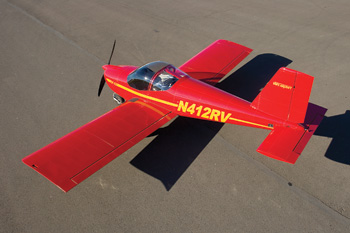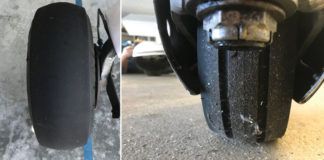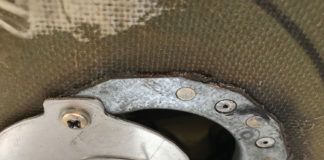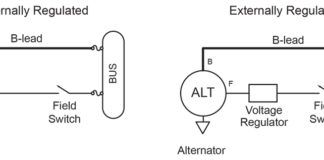
The horizontal tail has several functions, all of which are vital to providing acceptable flying qualities. The tail must stabilize the airplane in pitch. It must also trim out pitching moments caused by the wing, body and c.g. changes. Finally, the tail must provide control power so the pilot can maneuver the airplane. The designer must take all of these requirements into account when defining the size and configuration of the tail.
Stabilization
The pitch stability of an airplane determines how it responds to an angle-of-attack disturbance. The disturbance can come from a variety of sources including turbulence, control movements or power changes. A stable airplane is self-correcting. It will resist any perturbation that tries to deflect its flight path. If the nose of the airplane is raised, a nose-down pitching moment will be created, which will push the nose back down. If the nose is lowered, a nose-up pitching moment will be created, which will tend to raise the nose.
On a conventional airplane, this is the horizontal tails job. As the angle of attack changes, the tails lift changes in response, producing a moment opposing the change. If angle of attack increases, the lift of the tail increases and generates a nose-down (negative) pitching moment. Conversely, if the angle of attack decreases, the tails lift decreases, causing a nose-up (positive) change in pitching moment. These moment changes tend to drive the airplane back to its original trimmed angle of attack.
The stabilizing influence of the tail is a function of several factors. To the first order, the stability increment produced by the tail is proportional to the product of the tail arm multiplied by the tail area. Because this quantity has units of feet cubed, it is referred to as tail volume.
Tail aspect ratio also affects stability. A higher aspect ratio surface has a higher lift-curve slope. This means that a 1 change in angle of attack on a high aspect ratio surface produces a greater change in lift than on a low aspect ratio surface. Accordingly, a high aspect ratio tail is more stabilizing than a low aspect ratio one of the same area. The proper tail aspect ratio is a compromise. High aspect ratio surfaces provide more stabilization per unit area, but they are heavier, and stall at a lower angle of attack than lower aspect ratio surfaces.
Control surface characteristics also play a major role in determining the stabilizing effect of a tail. With the stick free, the elevators will tend to float with the wind. This means that they do not provide as much stability as they would have if they were held fixed. The floating tendency of the elevators is very dependent on details of the elevator geometry. Aerodynamic balance tends to reduce elevator float. Elevator chord and the details of the trailing-edge shape can also have a large effect.
Float can be a major issue with an all-moving tail. If the tail is hinged too far forward, the whole tail will float with the wind if the stick is free. From a stability viewpoint, this is aerodynamically equivalent to removing the tail. Designers counter this by hinging the all-moving tail at or near the 25% chord point, which eliminates both float and, unfortunately, any tendency for the tail to resist being deflected by the pilot. This will cause the airplane to be oversensitive in pitch, so an anti-servo tab is added to provide artificial pitch feel. A properly done all-moving tail can actually have some advantage over a fixed tail plus elevator setup because it does not have elevator float. This means that the stick-free and stick-fixed stability will be the same for the properly balanced all-moving system. The same effect can be achieved with an elevator by proper use of aerodynamic balance and either an anti-servo tab or centering springs. The Questair Venture used such a system.
Trim
The second function of the horizontal tail is to trim the airplane. When the airplane is in steady flight, all of the moments acting on it must be balanced so that there is no net moment about the center of gravity. An airplane that is in this state of moment equilibrium is trimmed. If the airplane is not trimmed, it will pitch either up or down.
The wing and body both produce aerodynamic pitching moments. For a conventional airplane, the tail-off (wing plus body) pitching moments are not balanced. The airplane will not be in trim without the addition of a pitching moment to counteract the wing and body moments. The horizontal tail provides this pitching moment by producing a force on the aft end of the fuselage that trims out the other moments. This trimming tail load may be either up or down, depending on the details of the airplane configuration, airfoil and c.g. position.
The tail load required to trim will change with angle of attack of the airplane and the position of the c.g. To trim the airplane at differing flight conditions, the pilot must be able to control the lift (or down force) of the tail. There are two ways of doing this. The first is to hinge the trailing edge of the tail to form an elevator surface attached to the back of a fixed tailplane. The pilot can change the camber of the tail by deflecting the elevator and hence change the lift of the tail.
The second approach is to pivot the whole tailplane so that the pilot can control the angle of attack of the tail directly. Combinations of these two approaches are not uncommon. Some airplanes have an elevator as the primary pitch control but also have variable-incidence tails. The pilot can adjust the incidence of the fixed portion of the horizontal tail to trim the airplane. Conversely, most airplanes with all-moving tailplanes have large, elevator-like tabs hinged to the trailing edge of the tail to control hinge moments and increase control power.
Variable-incidence tails with elevators are standard practice on large transport airplanes. Light airplanes typically use trimtabs set into the elevators to adjust the stick-free floating position of the elevators for trim. Variable incidence tails are used on some light airplanes, notably the venerable Cub, and the Mooney line of airplanes. The Mooneys are unusual because the whole tail unit, including the fin and rudder, move to change the incidence of the horizontal tail.
Pitch Control
The third function of the horizontal tail is pitch control or maneuvering. It is similar to trim in that the tail is used to generate pitching moments. When the pilot wishes to change the attitude or flight path, he must generate a moment that will pitch the airplane. This moment is different from the moment required to trim the airplane, as the pilot is deliberately putting the airplane out of trim to generate a pitch rate.
The horizontal tail of an airplane must be able to generate enough pitching moment so that the pilot can control the attitude and flight path at any point in the flight envelope. There are some flight conditions that require special attention when considering the control power required from the horizontal tail.
One of these critical conditions is nosewheel liftoff during takeoff. If the airplane has tricycle landing gear, the pilot must be able to rotate the airplane to a positive angle of attack for liftoff. It must be possible to lift the nose wheel at an airspeed below the stall speed with the airplane loaded to its most forward c.g. position. FAR part 23 requires that an airplane be able to lift its nosewheel when rolling at 85% of stall speed.
If the airplane has a tailwheel landing gear, there is a similar requirement that the airplane be able to lift the tailwheel off the ground when loaded to its aft c.g. limit while traveling at 80% of its stall speed. This tailwheel liftoff requirement can be troublesome if the airplane has an all-moving tail. If the choice of tail airfoil and travel is not correct, the pilot may stall the tail during the ground run and consequently be unable to rotate the airplane into a more level attitude for takeoff.
Another critical flight condition for tail sizing is the landing flare. With an airplane at its most forward c.g. and the flaps and landing gear down, the pilot must have enough pitch control available to trim the airplane and to bring the nose up in the final flare maneuver. To satisfy this last requirement, the airplane must have somewhat more control power available at normal landing speed than is necessary to simply trim the airplane. The pilot must be able to produce a nose-up pitch rate from the trim condition to flare the airplane and arrest its sink rate before ground contact.
A final flight condition that must be considered is pitch recovery from high angles of attack. The pilot must be able to lower the nose and reduce angle of attack to break the stall and retain control of the airplane. The elevator must have enough control power to produce a nose-down pitch rate at the highest angle of attack that the airplane is expected to achieve. The designer should note that this maximum angle of attack will be well beyond the angle of attack at which the wing first stalls. If the airplane approaches the stall with a large nose-up pitch rate, it will continue to nose up for some time after the wing has started to stall. By the time the pitch rate is zero, the angle of attack will be well above the nominal stall angle of attack. In extreme cases such as tail slides the angle of attack reached by this type of dynamic overshoot can be large.
It is also possible to reach larger than expected angles of attack because of gusts or turbulence. If the airplane is flying near the stall angle of attack and encounters a strong up or tail gust, the gust will induce a positive angle of attack change, and this may put the angle of attack above the stall angle of attack. It is of utmost importance that the pilot be able to force the nose down at any angle of attack to prevent a hung stall and loss of control.
Tail Design Considerations
The need for trim, stability and pitch control power place requirements on the design of the horizontal tail.
- The airplane must have sufficient tail volume to give the desired c.g. range. The aft limit is set by stability considerations, and the forward limit is set by nose-up control power considerations. Both are a function of tail volume.
- The pilot must be able to trim the airplane at all c.g. positions, and at all flap and landing gear configurations over its entire angle of attack range. It is desirable to provide a trim control that will allow the pilot to trim the airplane without exerting a continuous pressure on the controls.
- The airplane must have sufficient control power to produce pitch rates at all angles of attack. The most critical conditions are usually stall and high angle of attack recovery at aft c.g. positions, and nosewheel liftoff and landing flare at forward c.g. positions.
- Control surface hinge moments must be relatively linear and small enough for the pilot to overcome easily at all points in the flight envelope. Stick force reversals and unstable control surfaces should be specifically avoided.
- 5. The tail must remain unstalled throughout the flight envelope.
Stalling of the horizontal tail will usually result in loss of control, and it is of particular concern for airplanes that use all-moving tails because the pilot can change the tail angle of attack over a large range.
There are several situations in which tail stall can be encountered, and some can be extremely dangerous. One condition that has proven troublesome is the full-flap, forward c.g. configuration. In this situation, the tail must produce a large download to trim the airplane. If the tail is too small or stalls at too small a negative angle of attack, a small change in tail incidence such as the deflection required to trim the airplane in a turn can cause the lower surface of the tail to stall. If this happens, the airplane will pitch down, and the pilot will not be able to prevent it from doing so.
On early versions of one production light airplane, the pilot could not regain control until the airplane had pitched over to an inverted attitude. This caused accidents before the condition was diagnosed and could be fixed. The remedy was to put fixed slots in the leading edge of the tailplane to increase its stall angle of attack. Increasing tail size, changing tail airfoil or restriction of tail travel and c.g. can also solve this problem. Tail stalling can also be a problem when trying to recover the airplane from high angle of attack flight. This problem is more typical of modern fighters that fly at very high angles of attack.














Very interesting. As I am building an RV-12 it makes me realize the various complex flight characteristics and requirements that must go into the design.